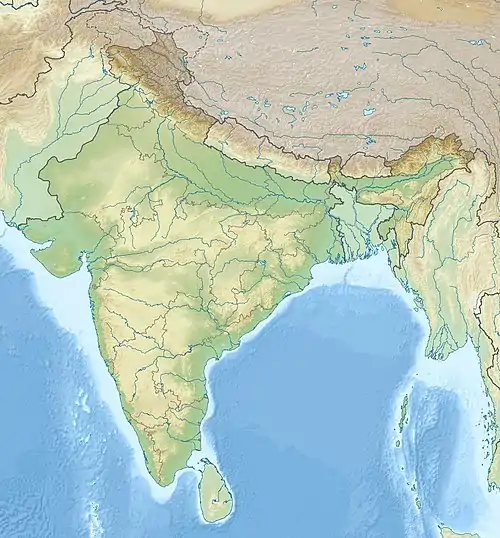| Khangchendzonga National Park | |
|---|---|
 | |
 Kanchenjunga NP  Kanchenjunga NP | |
| Location | Mangan district and Gyalshing district, Sikkim, India |
| Nearest town | Chungthang |
| Coordinates | 27°39′22.7″N 88°18′44.3″E / 27.656306°N 88.312306°E |
| Area | 1,784 km2 (689 sq mi) |
| Established | 1977 |
| Governing body | Ministry of Environment and Forests, Government of India |
| Type | Mixed |
| Criteria | iii, vi, vii, x |
| Designated | 2016 (40th session) |
| Reference no. | 1513 |
Khangchendzonga National Park, also Kanchenjunga Biosphere Reserve, is a national park and a biosphere reserve located in Sikkim, India. It was inscribed to the UNESCO World Heritage Sites list in July 2016, becoming the first "Mixed Heritage" site of India.[1] It was included in the UNESCO Man and the Biosphere Programme. The park is named after the mountain Kangchenjunga, which is the third-highest peak in the world at 8,586 m (28,169 ft) tall. The total area of the park is 849.5 km2 (328.0 sq mi).
History
Tholung Monastery is located in the park's buffer zone. It is considered one of the most sacred monasteries in Sikkim.[2] [3]
Geography

The Kanchenjunga Park is situated in the Mangan district and Gyalshing districts in the Indian state of Sikkim. It has an elevation of 1,829 m (6,001 ft) to over 8,550 m (28,050 ft) and has an area of 849.50 km2 (327.99 sq mi). It is one of the few high-altitude National parks of India and was designated a mixed-criteria UNESCO World Heritage Site in July 2016.[4]
In the north it adjoins the Qomolangma National Nature Preserve in Tibet, and in the west the Kanchenjunga Conservation Area in Nepal.[5]
Climate
heavy Snowfall during the winter months and monsoon showers occur from May to mid-October.
Flora
The vegetation of the park include temperate broadleaf and mixed forests consisting of oaks, fir, birch, maple, willow.[4] The vegetation of the park also includes Alpine grasses and shrubs at higher altitudes along with many medicinal plants and herbs.[6]
Fauna
The park contains many mammal species including musk deer, Indian leopard, snow leopard, Himalayan tahr, dhole, sloth bear, viverrids, Himalayan black bear, red panda, Tibetan wild ass, Himalayan blue sheep, mainland serow, goral and takin, as well as reptiles including rat snake and Russell's viper.
A 2014 study revealed that the dhole has become very rare in the area. The wild dogs in the Khangchendzonga Biosphere Reserve are thought to belong to the rare and genetically distinct subspecies C. a. primaevus.[7]
Avifauna
About 550 species of birds are found inside the park including blood pheasant, satyr tragopan, osprey, Himalayan griffon, lammergeier,several species of green pigeon, Tibetan snowcock, snow pigeon, impeyan pheasant, Asian emerald cuckoo, sunbird and eagle.[4]
References
- ↑ O'Neill, A. (2017). "Sikkim claims India's first mixed-criteria UNESCO World Heritage Site" (PDF). Current Science. 112 (5): 893–994. Archived (PDF) from the original on 29 March 2017. Retrieved 11 May 2017.
- ↑ "Khangchendzonga National Park: Tholung monastery in the buffer zone of KBR". UNESCO World Heritage Centre. Archived from the original on 14 April 2017. Retrieved 14 April 2017.
- ↑ "Tholung Monastery (1789 AD)". Department of Ecclesiastical Affairs, Government of Sikkim. Department of Information Technology Government of Sikkim. Archived from the original on 15 April 2017. Retrieved 14 April 2017.
- 1 2 3 O'Neill, A. R. (2019). "Evaluating high-altitude Ramsar wetlands in the Sikkim Eastern Himalayas". Global Ecology and Conservation. 20 (e00715): 19. doi:10.1016/j.gecco.2019.e00715.
- ↑ Bhuju, U. R.; Shakya, P. R.; Basnet, T. B. & Shrestha, S. (2007). "Kanchenjunga Conservation Area". Nepal Biodiversity Resource Book. Protected Areas, Ramsar Sites, and World Heritage Sites. Kathmandu: International Centre for Integrated Mountain Development, Ministry of Environment, Science and Technology, in cooperation with United Nations Environment Programme, Regional Office for Asia and the Pacific. ISBN 978-92-9115-033-5. Archived from the original on 5 May 2021. Retrieved 10 January 2021.
- ↑ O'Neill, A. R.; Badola, H.K.; Dhyani, P. P.; Rana, S. K. (2017). "Integrating ethnobiological knowledge into biodiversity conservation in the Eastern Himalayas". Journal of Ethnobiology and Ethnomedicine. 13 (1): 21. doi:10.1186/s13002-017-0148-9. PMC 5372287. PMID 28356115.
- ↑ Bashir, T.; Bhattacharya, T.; Poudyal, K.; Roy, M.; Sathyakumar, S. (2014). "Precarious status of the Endangered Dhole Cuon alpinus in the high elevation Eastern Himalayan habitats of Khangchendzonga Biosphere Reserve, Sikkim, India". Oryx. 48 (1): 125–132. doi:10.1017/S003060531200049X.
External links
- Khangchendzonga National Park, WebIndia123
- Goecha La: In search of Kangchenjunga by George Thengummoottil - documentary on Goechala Trek inside Kangchenjunga National Park
 Khangchendzonga National Park travel guide from Wikivoyage
Khangchendzonga National Park travel guide from Wikivoyage
